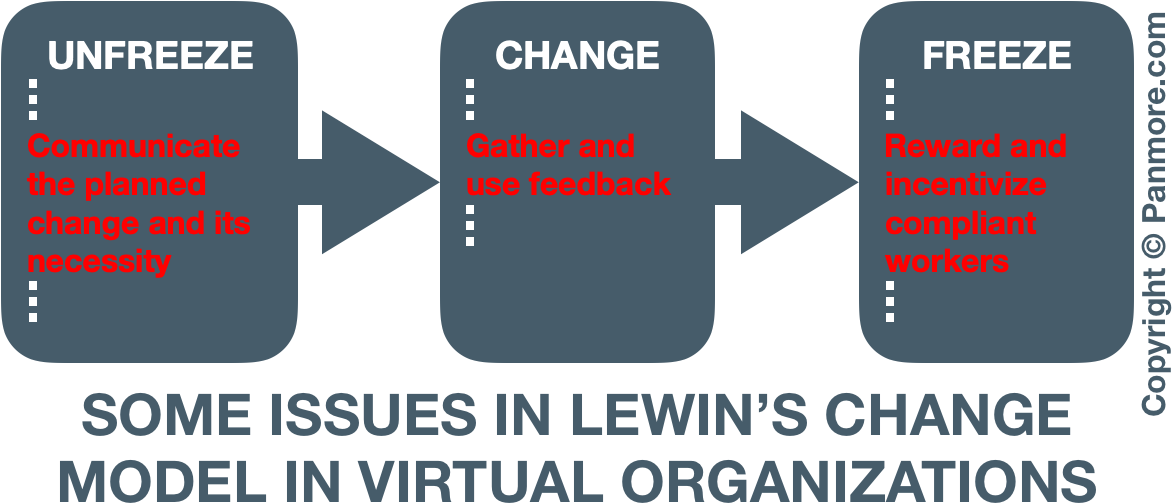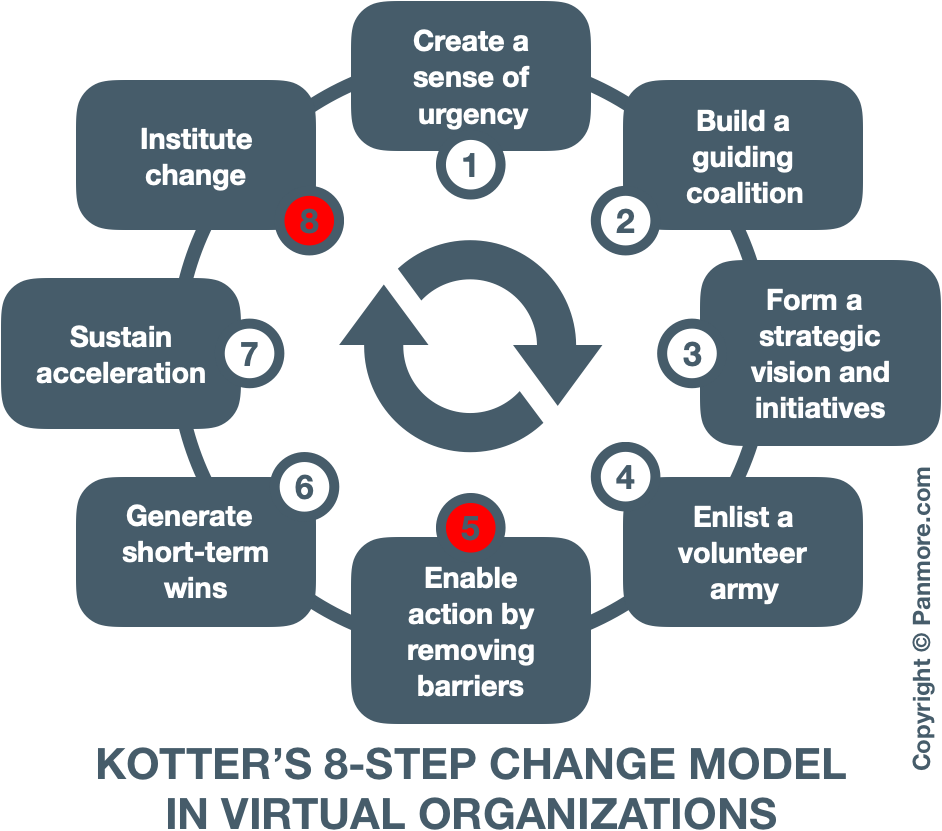
Effective organizational change can ensure long-term business competitiveness and resilience. Innovative organizational change helps technology companies, like Apple, Google (Alphabet), Microsoft, Intel, IBM, GE, and Amazon, achieve their business goals and maintain their strategic positions against the competition. In transforming their organizations, business leaders consider factors that support or hinder the desired change. Internal business strengths and weaknesses are relevant, along with external factors based on the industry environment. Using organizational change models or modifications thereof, effective change management aligned with the company’s long-term strategies can push the organization toward a successful transformation. However, change imposes challenges, especially in virtual organizations with multinational workforces. An in-depth understanding of these challenges and related organizational factors in virtual workplaces helps develop change management approaches and tactics that optimize human resource support for the desired change.
Virtual or boundaryless organizations involve geographically separate workers or work teams. Communications among employees typically occur through the Internet, and non-online face-to-face communication is minimal or non-existent. E-mails and instant messaging services are used for efficient internal business communications, as well as for external communications with customers. This nature of virtual organizations imposes challenges and issues in change management and related strategies and tactics.
Characteristics of Virtual Organizations
Reduced geographic collocation is a primary defining factor in virtual organizations. Some virtual companies have the majority of their employees working from home, while other virtual firms have multiple unstructured physical offices that communicate among each other through the Internet. As more companies adopt new models for their organizational structures and organizational designs, the likelihood of transitions into virtual organizations increases. The time and cost savings in transportation is a driving force in these transitions. Also, schedule flexibility and convenience are factors that make jobs in virtual organizations attractive to workers.
Critical dependence on information and communication technologies (ICT) also defines virtual organizations. In this case, all or the vast majority of business communications require the use of these technologies, especially in long-distance communication. Many multinational companies, like Starbucks, Disney, Sony, and General Motors, use these technologies for their communication needs to achieve their strategic goals and business vision. However, these firms are not true virtual organizations. A true virtual organization depends on information and communication technologies, cannot function without these technologies, and has the bulk of its operations in virtual processes and transactions.
Reduced organizational structure rigidity is a consequence of the reduced collocation and related work flexibility and employee autonomy in virtual organizations. The extensive use of information and communication technologies in virtual companies creates various opportunities for employees to communicate, cooperate, and collaborate. This condition leads to the development of horizontal and diagonal communication lines that flatten the organization and weaken its structural rigidity.
High dependence on trust and employees’ reliability is a factor that influences the performance of virtual organizations. Virtual companies’ managers need to trust that their employees are doing their jobs in a geographically distant location, even when without direct face-to-face supervision and communication. Virtual employees need to be reliable in fulfilling their work requirements despite the absence of non-online face-to-face leadership, management, and supervision.
Communication Issues
The lack of collocated face-to-face communication reduces communication effectiveness in virtual organizations. Even in video calls and videoconferencing, fine details of facial expressions and gestures are lost. Employees could misinterpret each other, leading to confusion, job ineffectiveness, operational inefficiency, and other problems in the business. Loss of valuable information along lines of communication is a possible consequence that affects organizational change management profitability and overall business performance.

Communication issues in virtual organizations present challenges in organizational change implementation, particularly in terms of communication effectiveness and the timing and availability of information. For example, miscommunication in online correspondence could result in incorrect changes in operations. Inefficient communication, such as repeating the same online messages because of misinterpretation, leads to the possibility of reduced practical value of information. This information value issue arises from the importance of providing the right information at the right time, especially in time-dependent strategic changes. In this regard, transforming a virtual organization requires focus and attention to communication problems, and immediately addressing these problems. As depicted in the diagram above, in Lewin’s Change Model, these communication issues can prevent successful organizational change and transformation in the unfreezing, changing, and (re)freezing stages.
Challenges in Workflows and Workplaces
Workflows in boundaryless or virtual organizations are similar to workflows in non-virtual work environments. However, virtual workflows impose managerial challenges, especially in terms of efficiency and productivity, as well as predictability, which is an issue based on the reduced rigidity of virtual organizational structures. Managers have reduced control and influence on the actual activities of virtual workers during their work time, despite institutionalized procedures in the organization. For example, a virtual employee working from home could intermittently attend to household chores during scheduled work hours. Moreover, managers do not have access to information about the characteristics of each employee’s work setting. This condition creates blind spots in strategic management and organizational change.
In implementing organizational change, a virtual organization needs to address these challenges related to workflows. Managers must know and understand how workers do their jobs, and not just know the prescribed way of doing these jobs. This challenge is difficult to address, considering the virtual nature of communication in the organization. Employees might not be willing to provide accurate information about all their activities during their work hours. Lack of managers’ access to actual workflow information makes it difficult to ascertain occupational safety issues that hinder successful organizational change management. Furthermore, in terms of workplace characteristics, obstacles and disorder in the individual employee’s workplace affect workflow efficiency and productivity. In the Broken Windows Theory, disorderliness is a factor that encourages delinquent behavior. In the process of organizational change, such factors could hinder successful changes in the employee’s workflow and related behaviors.
Technological Barriers to Organizational Change Implementation
The critical dependence of virtual organizations on information and communication technologies imposes technological barriers and challenges in implementing and managing organizational change. For example, changes in technological tools, functions, processes, and procedures typically accompany organizational changes in virtual companies. This technological aspect imposes barriers to successful organizational change through difficulties in adopting new technologies. The individual worker may find it difficult to use new technologies, or to integrate new tools in the workflow, considering the actual virtual workplace setting’s characteristics.

In Kotter’s 8-Step Change Model, as shown above, these technological barriers are especially significant in the fifth step, which involves the removal of barriers, and the eighth stage, which is the institutionalization of the change. As noted earlier, managers may lack an accurate picture of the actual barriers in virtual employees’ work activities and environment, leading to the difficulty of removing these barriers. In addition, institutionalizing the change requires a holistic approach, which is difficult to achieve in a virtual or boundaryless organization.
Sociocultural Factors
Sociocultural issues arise from the geographical variety of virtual organizations’ human resources. Employees’ culture in one region may differ from the cultures of other employees in other regions. These differences come with biases that affect strategic management and organizational change. Virtual workers’ perceptions of internal business communication regarding the desired change may vary, depending on their sociocultural contexts and biases. In managing organizational change, leaders must account for these sociocultural factors. Thus, effective change management should involve an understanding of workers’ cultures and how cultural factors could hinder change at the individual, team, and organizational levels.
In addition, the immediate social environment in the individual employee’s virtual workplace is a factor in the success of organizational change management. Social dynamics, such as the work-from-home virtual employee’s interactions with family members during work hours, determine how the employee accepts, supports, and applies the desired organizational change. In non-virtual organizations, managers have strong control and influence on the social characteristics of the workplace through the company’s organizational culture and related programs and initiatives. However, in virtual organizations, this managerial control and influence is minimal or absent. Consequently, organizational change is more difficult in virtual companies, as the social tools for change management are rendered weak or ineffective.
Solving Issues and Challenges in Organizational Change Management in Virtual Companies
Successfully changing a virtual organization requires a holistic understanding of the issues linked to communication, workflows and workplaces, technological barriers, and sociocultural factors. Managers can address communication issues by practicing concise but detailed communication in speech and writing. Virtual employees should also do the same. The challenges in workflows and workplaces require openness among management, to encourage workers to provide personal information about their actual workflows and workplaces, as well as their sociocultural environments. To overcome the technological barriers to organizational change, leaders and managers must institutionalize programs and procedures to achieve streamlined and easy transitions to using new technologies. The involvement of the IT Department is essential for this purpose.
In addition to these approaches, modifications are necessary in organizational change models when applying them. Traditional change models, such as Lewin’s and Kotter’s, are most suited to non-virtual organizations. The characteristics and issues involving virtual organizational design reduce the effectiveness of these traditional models. Nonetheless, adjustments in these models could lead to success in change implementation. For example, regular one-on-one interviews involving a supervisor in a specialized role can gather data about individual workers’ virtual workplace characteristics and sociocultural environments. The resulting information can help managers develop a change model aligned to the specific needs of the virtual organization and its human resources.
References
- Demir, S., & Hadžiahmetović, N. (2024). Effect of transformational leadership on virtual team performance: The mediating role of knowledge sharing. Journal of Global Economics and Business, 5(17), 25-43.
- Hubbart, J. A. (2024). Organizational change: Implications of directive change management. Human Resources Management and Services, 6(2), 3457-3457.
- Lynden, K. D. (2024). A meta-review of global virtual team research: Thematic insights and future directions. Cross Cultural & Strategic Management, 31(2), 205-242.
- Mahadevan, J. (2024). Building Collaborative Cultures in Cross-Functional and Interdisciplinary Virtual Teams: Relationship Management, Project Time Planning and Workspace Organization. In Virtual Team Collaboration: A Guide for Individual Team Members (pp. 99-131). Wiesbaden: Springer Fachmedien Wiesbaden.
- Majnoor, N., & Vinayagam, K. (2024). The profound influence of technological advancements in organizational change management. Educational Administration: Theory and Practice, 30(4), 9786-9794.
- Manubrahma, S., Shireesha, S., & Varalakshmi, T. (2024). Effect of change management strategies on organizational transformation. International Research Journal on Advanced Engineering and Management (IRJAEM), 2(05), 1580-1583.
- Mizrak, F. (2024). Effective change management strategies: Exploring dynamic models for organizational transformation. In Perspectives on Artificial Intelligence in Times of Turbulence: Theoretical Background to Applications (pp. 135-162). IGI Global.
- U.S. Department of Commerce – International Trade Administration – Software and Information Technology Industry.